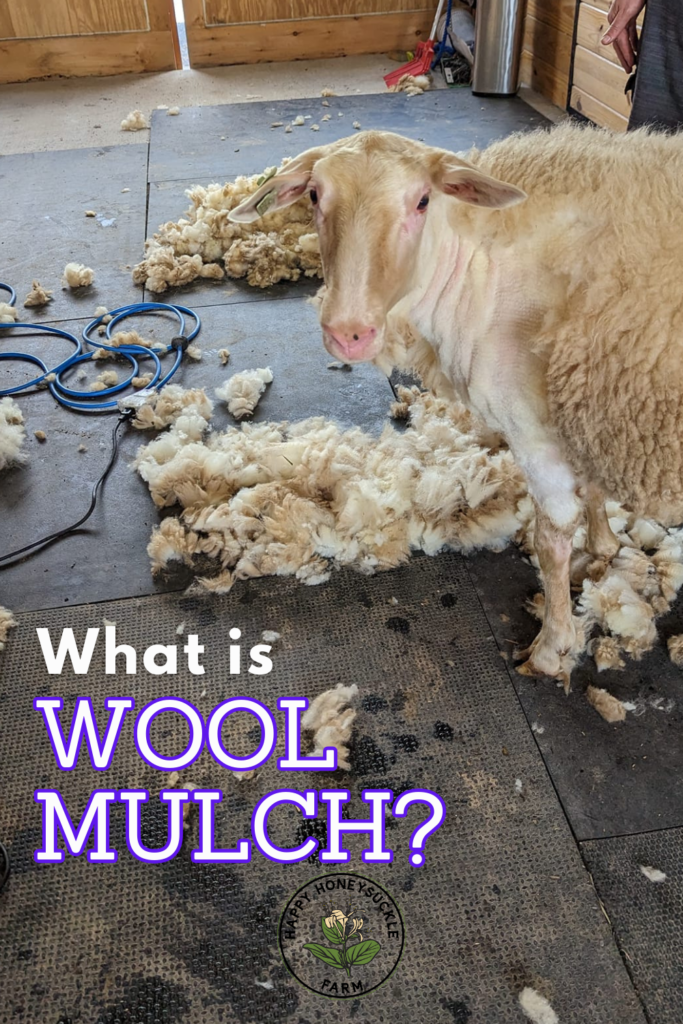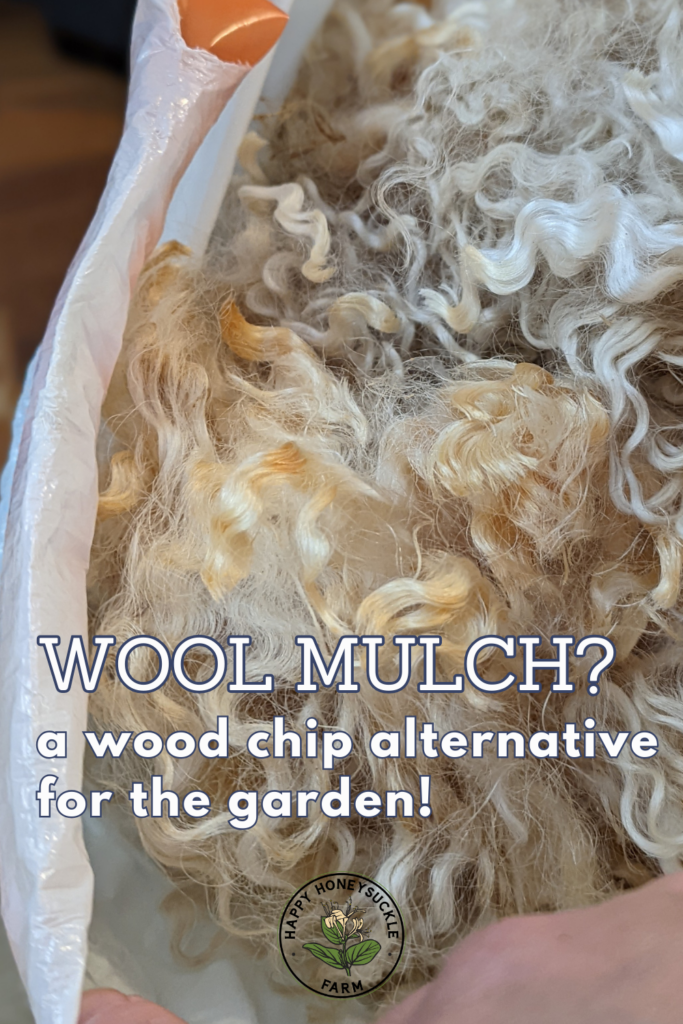Have you ever considered using wool as mulch in your garden? Explore the idea of using wool as an alternative to wood mulch, the benefits of wool mulch, and the cost.

Wool is a byproduct of raising sheep… while hair sheep shed their fur, wool breeds have wool which needs to be sheared 1-2x per year for their personal comfort. Local farmers can send this wool to a mill to be processed into roving, yarn, or products like socks, but it’s also quite expensive to have done. And some sheep, particularly those raised for meat or milk, don’t produce high quality wool with a high value. So the wool may go to waste. Some farmers switch to hair sheep, but I think it would be sad to see so many great wool breeds loose prominence in the sheep world. Let’s talk about how you can help support local farms by using raw wool in your garden as mulch!
This post may contain affiliate links which may earn me commissions should you click through them and take certain actions. As an affiliate for Amazon and other sites, I earn from qualifying purchases. This is a blog. It should not be considered professional advice. Research topics carefully to ensure that you’re getting the most up-to-date information. Please read the whole post so you don’t miss any important information!
What is Mulch? Why Does It Matter in the Garden?
Mulch is a layer of material applied to the surface of soil. It can be organic—such as bark chips, leaves, straw, wool, pine straw, and grass clippings—or inorganic, like rocks, rubber chips, and plastic sheeting.
- Purpose:
- Moisture Retention: Mulch helps soil retain water, reducing the need for frequent watering.
- Weed Control: By blocking sunlight, mulch prevents weed seeds from germinating.
- Temperature Control: Mulch acts as an insulator, keeping soil cooler in the summer and warmer in the winter.
- Benefits:
- Soil Health: Organic mulches decompose over time, enriching the soil with nutrients.
- Erosion Prevention: Mulch reduces soil erosion by buffering rain impact and slowing water runoff.
- Aesthetic Appeal: Mulch can enhance the look of garden beds, offering a tidy, cohesive appearance.
How to Use Wool as Mulch in the Garden
Step 1: Remove wool from your plastic garbage bags. I usually just dump it all out.
Step 2: Raw wool is thick and often felted together so it will need to be pulled apart a bit to spread it out as much as possible. You want your layers of mulch to be around 2-3″ thick.
Step 3: Placed your wool around the plant or tree, leaving the stem/trunk plenty of breathing room. You don’t want the wool right up against the stem as this can ‘choke’ the plant and cause issues with its health and long term survival.
Step 4: If the wool is very dry (or the soil is), you can consider spraying it down with a hose to ensure it doesn’t fly away in the wind. I found mine was pretty thick and heavy so it wasn’t an issue, but I think different types of wool may be different to work with.
Make sure to check on your mulch routinely to ensure it’s not covering plants that you want. I may place our drip system under the wool mulch to help lose less water to evaporation.
Benefits of Wool as a Mulch
When testing wool mulch in my garden, I found that it effectively suppressed weed growth, retained moisture in the soil, and deterred pests.
I anticipate that it will also help keep the garden soil warm over the colder months. This may be beneficial for speeding up when seeds germinate, depending on the plant… some seeds need cold stratification so warm soil isn’t necessarily the right choice for them.
It’s lightweight to handle and I strongly prefer managing bags of wool over bags of wood mulch, and I found it easy to spread. It also looks like fluffy clouds in my garden!
I believe that pests seem to be avoiding the wool; I haven’t seen slugs near my plants and I am not seeing ants like I do with wood mulch.
This product is sustainable and will compost into the soil long term, but I believe it may take longer to compost than wood mulch based on what I’ve seen and heard of this so far. I’m hoping that one layer of wool will last 1-2 years, but I’ll try to update the post once I see how it goes!
Where to Buy Raw Wool
If you have a local farming group, you can inquire about raw waste wool on there. You could also contact your local farm bureau or extension office, or check in with the 4H groups in your area.
GOOD quality wool is QUITE expensive ($60+ per bag) as it’s used for spinning and many people enjoy the process of processing fiber by hand. You want to ensure that you’re asking about waste wool. This is usually wool from the back of the sheep, from the belly of the sheep, or it’s wool produced by animals that aren’t bred for high quality wool. I’ve seen waste wool for sale for around $10/garbage bag.
Help me grow my farm’s reach by sharing this post on social media, particularly Pinterest! Thank you!


